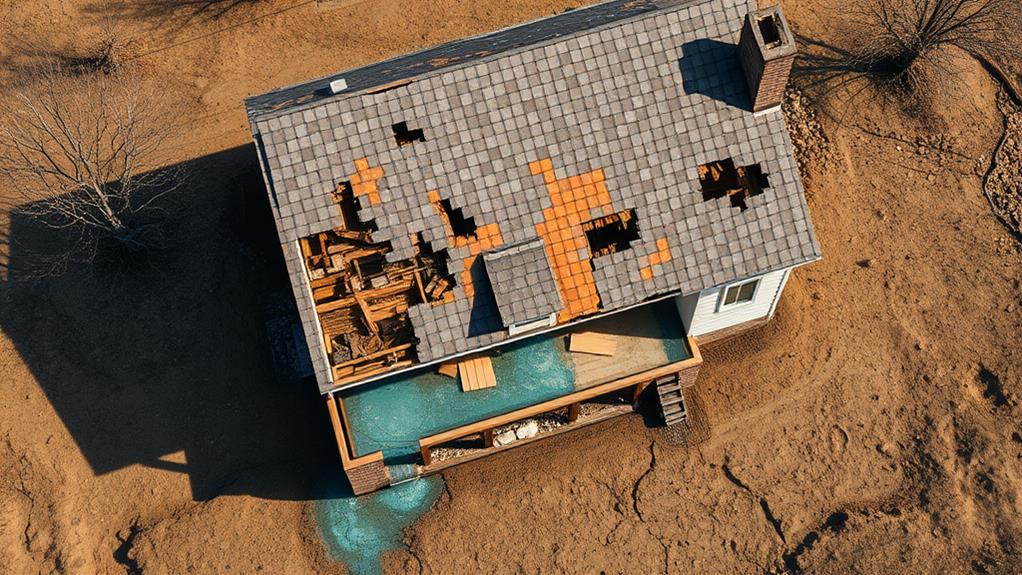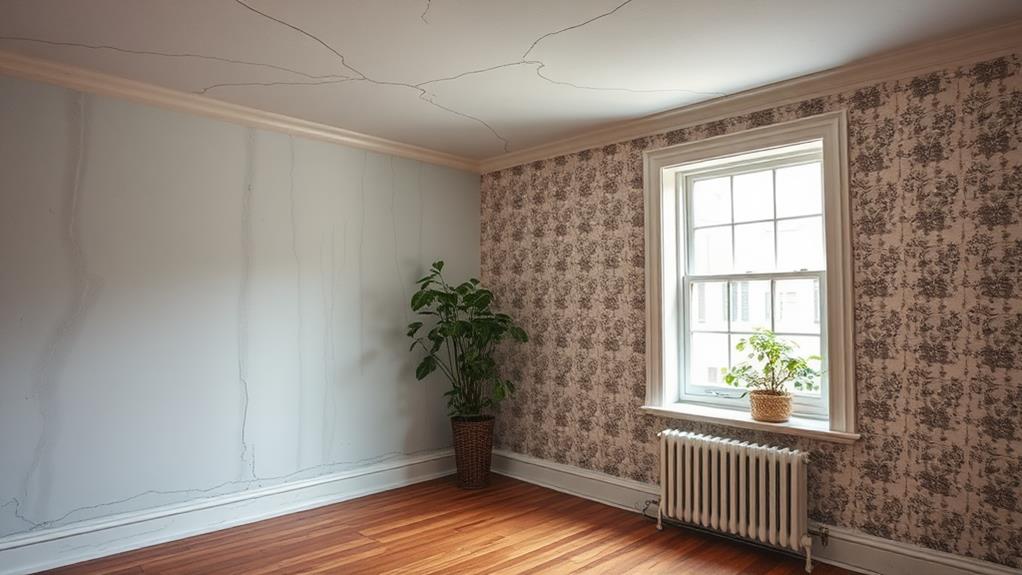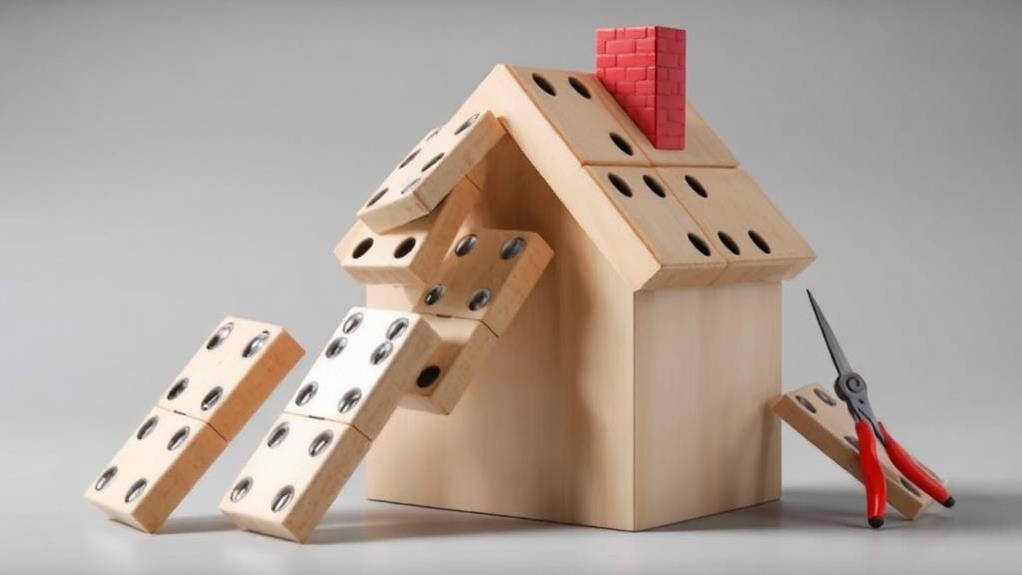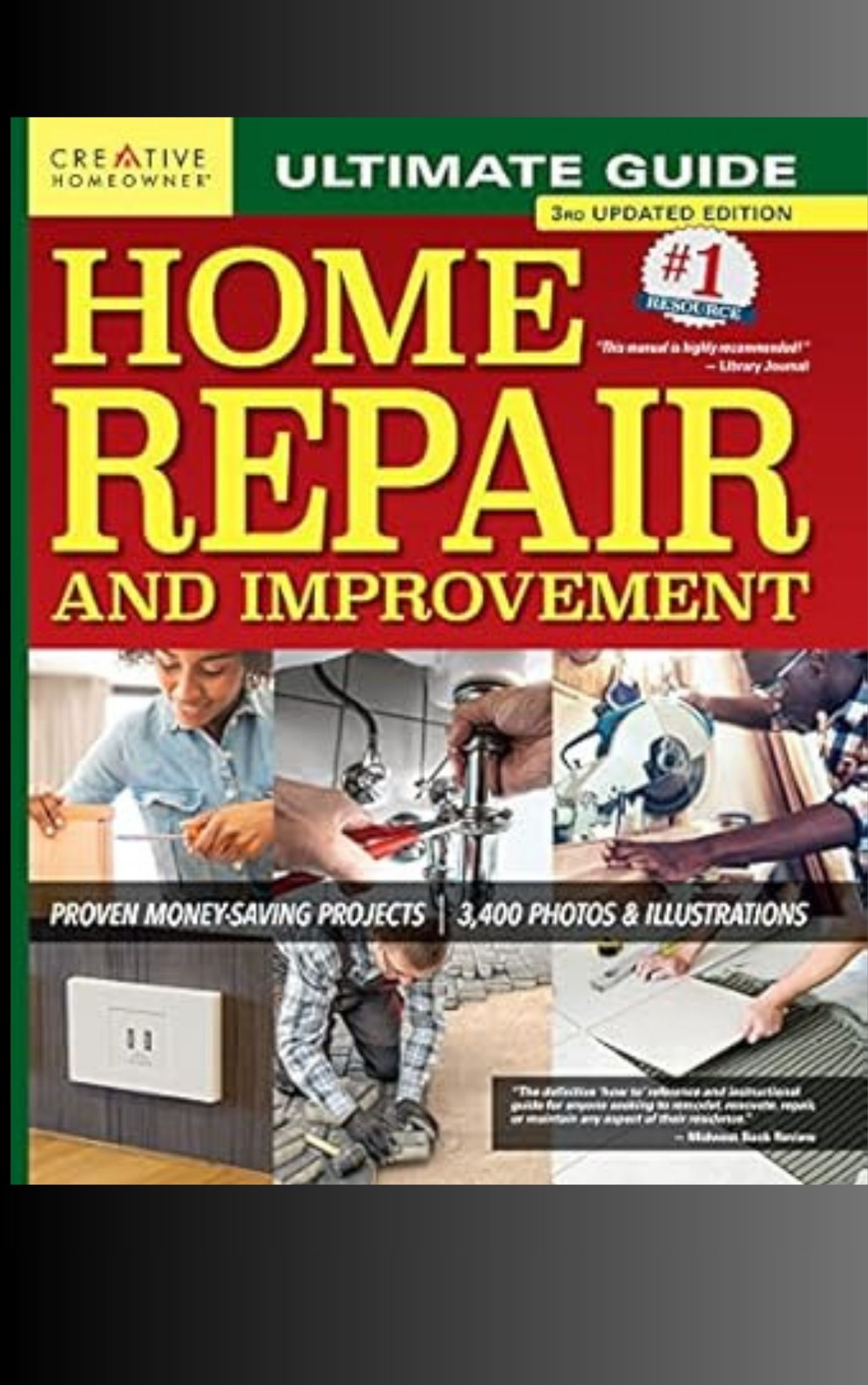Roof damage can trigger a domino effect of structural issues that ultimately impact a home's foundation. A compromised roof allows water infiltration, weakening structural elements from top to bottom. This moisture can lead to wood rot, mold growth, and soil erosion around the foundation. As water accumulates, it exerts hydrostatic pressure on basement walls and saturates the surrounding soil. Over time, this can cause foundation settling, cracks, and instability. Early warning signs include wall cracks, sticking doors, uneven floors, and water pooling near the foundation. Understanding this interconnected relationship highlights the importance of maintaining a sound roof to protect the entire structure.
Understanding the Roof-Foundation Connection

Through a complex interplay of structural elements, a building's roof and foundation are intimately connected. The roof serves as the primary defense against the elements, protecting the entire structure from water infiltration, wind damage, and temperature fluctuations. When the roof becomes compromised, it can set off a chain reaction that ultimately affects the foundation.
The connection between roof and foundation is primarily facilitated by the walls and load-bearing components of the building. A damaged roof can allow water to seep into these structural elements, weakening them over time. This weakening can lead to subtle shifts in the building's weight distribution, placing uneven stress on the foundation.
Furthermore, a damaged roof may fail to properly channel water away from the building's perimeter. This can result in water pooling around the foundation, leading to soil erosion, hydrostatic pressure, and potential foundation settlement. The roof's role in maintaining proper attic ventilation also impacts the foundation, as poor ventilation can lead to moisture buildup, affecting the structural integrity of the entire building from top to bottom.
Common Types of Roof Damage
A roof's integrity can be compromised by various forms of damage, each with its own potential to affect the underlying structure. Missing or damaged shingles are a common issue, often resulting from high winds or aging materials. These exposed areas allow water to penetrate the roof deck, leading to leaks and potential structural decay.
Cracked or curling shingles can also create vulnerabilities, typically caused by prolonged sun exposure or inadequate ventilation. Ice dams, formed by freeze-thaw cycles, can force water under shingles and into the home.
Flashing damage around chimneys, vents, and skylights is another frequent problem, compromising the roof's water-tight seal. Sagging or dipping areas on the roof indicate underlying structural issues, often stemming from water damage or inadequate support. Granule loss on asphalt shingles, while seemingly minor, can accelerate shingle deterioration and reduce the roof's effectiveness.
Punctures from fallen branches or improperly installed equipment can create direct entry points for water. Lastly, poor installation or substandard materials can lead to premature roof failure, potentially causing widespread damage to the home's structure.
Water: The Silent Destroyer

Water, often referred to as the universal solvent, poses a significant threat to a home's foundation when roof damage allows its intrusion. As rainwater seeps through compromised roofing materials, it can infiltrate the attic space, walls, and eventually reach the foundation. This silent destroyer gradually weakens the structural integrity of the building from top to bottom.
When water accumulates around the foundation, it creates hydrostatic pressure, forcing moisture through tiny cracks and pores in the concrete. This leads to basement leaks, mold growth, and potential structural instability. Furthermore, water can cause soil erosion around the foundation, leading to settling and shifting of the entire structure.
In colder climates, the freeze-thaw cycle exacerbates the problem. Water that seeps into cracks expands when frozen, widening existing fissures and creating new ones. This continuous cycle can cause severe foundation damage over time. Additionally, prolonged moisture exposure can corrode steel reinforcements within concrete foundations, further compromising their strength. To prevent these cascading effects, it's crucial to address roof damage promptly and ensure proper drainage systems are in place to divert water away from the foundation.
Soil Erosion and Foundation Shifting
Soil, the very ground upon which a home stands, can become a significant threat to its foundation when roof damage allows excessive water infiltration. As water accumulates around the foundation, it saturates the soil, causing it to expand and exert pressure on the structure. This hydrostatic pressure can lead to cracks in the foundation walls and floors.
Moreover, as the soil becomes oversaturated, it loses its ability to support the weight of the building. This instability can result in foundation settling, where parts of the structure sink unevenly into the ground. Differential settlement occurs when various sections of the foundation sink at different rates, causing structural imbalance and potential damage to the entire house.
The erosion process can also wash away soil particles, creating voids beneath the foundation. These voids compromise the structural integrity of the building, potentially leading to more severe foundation issues over time. In areas with expansive clay soils, the problem is further exacerbated as these soils undergo significant volume changes with fluctuating moisture levels, causing even more stress on the foundation.
Identifying Early Warning Signs

Homeowners' vigilance in detecting early warning signs of foundation issues can prevent catastrophic damage and costly repairs. Several indicators may suggest developing foundation problems stemming from roof damage. Cracks in walls, especially those wider than 1/4 inch or growing over time, warrant immediate attention. Doors and windows that stick or fail to close properly can indicate foundation shifting. Uneven floors or visible gaps between walls and floors are also telltale signs of foundation issues.
Exterior signs include cracks in brick or stonework, particularly those that form stair-step patterns. Separation between the house and attached structures like garages or porches may signal foundation movement. Water pooling near the foundation after rainfall can indicate improper drainage, potentially leading to soil erosion and foundation instability. Homeowners should also be alert to musty odors or visible mold in basements or crawl spaces, as these may indicate moisture problems affecting the foundation.
Regular inspections of both the roof and foundation are crucial. By identifying these early warning signs, homeowners can address issues promptly, preventing minor problems from escalating into major structural concerns that compromise the integrity of their homes.
Long-Term Structural Consequences
When left unaddressed, the early warning signs of foundation issues can lead to severe long-term structural consequences. As water infiltrates the home through damaged roofing, it compromises the structural integrity of load-bearing walls, floors, and the foundation itself.
Over time, this moisture exposure can cause wood rot in support beams and floor joists, weakening the overall frame of the house.
The foundation may experience significant settling or shifting, resulting in uneven floors, cracked walls, and misaligned doors and windows. These issues can escalate to more severe problems, such as bowed walls or a completely collapsed foundation. In extreme cases, the entire structure may become unstable and unsafe for occupancy.
Additionally, prolonged moisture exposure can lead to mold growth, which poses health risks to occupants and further degrades building materials. The electrical system may also be compromised, increasing the risk of fire hazards. Plumbing lines can become damaged or misaligned, leading to leaks and water damage throughout the home. Addressing these compounding issues often requires extensive and costly repairs, potentially involving complete foundation replacement or structural rebuilding.
Preventive Maintenance Strategies

Several preventive maintenance strategies can help homeowners protect their roofs and foundations from water-related damage. Regular roof inspections, ideally twice a year, allow for early detection of issues like loose shingles, damaged flashing, or clogged gutters. Prompt repairs of these problems prevent water infiltration and subsequent foundation damage.
Maintaining clean and functional gutters and downspouts is crucial. These systems direct water away from the home's foundation, reducing the risk of soil erosion and water accumulation. Installing gutter guards can minimize debris buildup and ensure proper water flow.
Proper grading around the house is essential. The soil should slope away from the foundation at a rate of about 6 inches over 10 feet. This prevents water from pooling near the foundation and seeping into the basement or crawl space.
Installing a French drain system can effectively manage excess water around the foundation. This underground drainage system redirects water away from the house, reducing hydrostatic pressure on foundation walls.
Regular inspection of the foundation itself for cracks or signs of settlement allows for early intervention. Sealing minor cracks and addressing drainage issues promptly can prevent more severe foundation problems in the future.
Professional Inspection and Repair
Professional inspection and repair services play a critical role in maintaining the integrity of both roofs and foundations. Experienced contractors can identify early signs of damage that may not be apparent to homeowners, potentially preventing minor issues from escalating into major structural problems.
For roof inspections, professionals assess the condition of shingles, flashing, gutters, and underlying structures. They look for signs of water infiltration, damaged or missing shingles, and areas prone to leaks.
Foundation inspections involve examining the home's exterior for cracks, settling, or shifts in the structure. Interior checks may include assessing floor levelness, wall cracks, and door or window misalignment.
Upon identifying issues, repair specialists can implement targeted solutions. For roofs, this may involve replacing damaged shingles, repairing flashing, or addressing ventilation problems. Foundation repairs might include crack sealing, installing support piers, or implementing drainage improvements to divert water away from the structure.
Regular professional inspections, typically recommended annually or bi-annually, can catch problems early, saving homeowners significant expenses in the long run. By addressing roof and foundation issues promptly, property owners can maintain their home's structural integrity and prevent the domino effect of cascading damage.
Frequently Asked Questions
Can Roof Damage Affect Indoor Air Quality and Mold Growth?
Yes, roof damage can significantly impact indoor air quality and promote mold growth. Leaks allow moisture to enter the home, creating damp conditions that are ideal for mold proliferation. This can lead to respiratory issues and other health concerns.
How Does Attic Insulation Play a Role in Preventing Roof-Related Foundation Issues?
Coincidentally, attic insulation serves a dual purpose. It regulates temperature, preventing ice dams and moisture buildup that can lead to roof damage. This protection extends to the foundation, as it mitigates water intrusion and structural stress.
Are Certain Roofing Materials More Prone to Causing Foundation Problems?
Certain roofing materials can indeed contribute to foundation problems. Heavy materials like slate or clay tiles may stress the structure, while materials prone to water retention or poor drainage can lead to soil saturation and foundation instability.
Can Landscaping Choices Impact the Relationship Between Roof Damage and Foundation Issues?
Landscaping choices can significantly impact the relationship between roof damage and foundation issues. Proper grading, strategic plant placement, and efficient drainage systems can mitigate water accumulation near foundations, reducing the risk of damage from roof-related water issues.
How Do Building Codes Address the Connection Between Roof Integrity and Foundation Stability?
Building codes mandate comprehensive structural integrity, linking roof and foundation. They specify load-bearing requirements, drainage systems, and moisture control measures. Inspections ensure compliance, while updates address evolving construction techniques and environmental challenges to maintain building stability and safety.
Conclusion
The roof-foundation connection underscores the importance of comprehensive home maintenance. Neglecting roof damage can precipitate a cascade of issues, from water infiltration to soil erosion, ultimately compromising structural integrity. Vigilant homeowners recognize early warning signs, implement preventive strategies, and seek professional assessments. By addressing roof problems promptly, foundation issues can be averted, preserving the home's stability and value. Regular inspections and timely repairs safeguard the entire structure, ensuring longevity and peace of mind for years to come.

